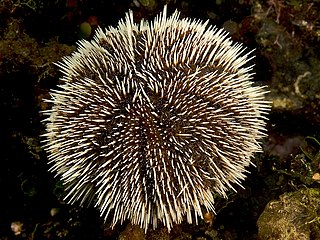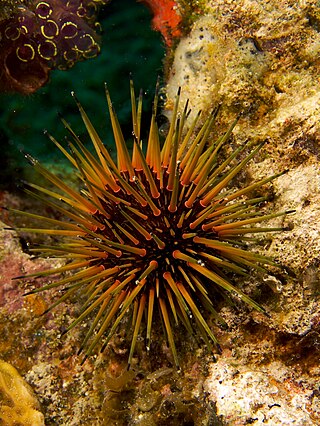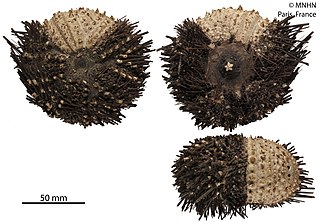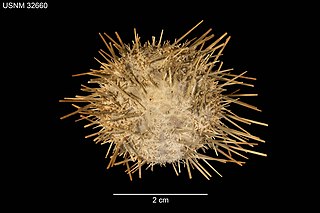
The diadema urchin or blue-black urchin is a species of tropical sea urchin, member of the Diadematidae family.

Diadema antillarum, also known as the lime urchin, black sea urchin, or the long-spined sea urchin, is a species of sea urchin in the family Diadematidae.

Echinus esculentus, the European edible sea urchin or common sea urchin, is a species of marine invertebrate in the Echinidae family. It is found in coastal areas of western Europe down to a depth of 1,200 m (3,900 ft). It is considered "Near threatened" in the IUCN Red List of Threatened Species.

Meoma ventricosa, known by the common names cake urchin and red heart urchin, is a large species of sea urchin which lives in shallow waters in the Caribbean. It may reach a diameter of twenty centimeters and is covered in reddish-brown spines. It has both pentagonal radial symmetry and bilateral symmetry, giving it a sand-dollar appearance; however, two of its five sections are merged more closely than the others.

Lytechinus variegatus, commonly called the green sea urchin or the variegated sea urchin, is a species of sea urchin that can be found in the warm waters of the western Atlantic Ocean and Caribbean Sea.

Loxechinus albus is an echinoderm of the family Parechinidae, native to coastal southern South America, ranging from Ecuador, along the entire coasts of Peru and Chile, to Argentina, as well as the Falkland Islands. It is the only species in the genus Loxechinus. It is known as the Chilean sea urchin or red sea urchin, but the latter name is typically used for the North Pacific Mesocentrotus franciscanus and it is not the only species of sea urchin in Chile. L. albus is found on rocky reefs and shores in the intertidal and subtidal zones to a depth of 340 m (1,120 ft).

Tripneustes ventricosus, commonly called the West Indian sea egg or white sea urchin, is a species of sea urchin. It is common in the Caribbean Sea, the Bahamas and Florida and may be found at depths of less than 10 metres (33 ft).

Toxopneustes pileolus, commonly known as the flower urchin, is a widespread and commonly encountered species of sea urchin from the Indo-West Pacific. It is considered highly dangerous, as it is capable of delivering extremely painful and medically significant stings when touched. It inhabits coral reefs, seagrass beds, and rocky or sandy environments at depths of up to 90 m (295 ft). It feeds on algae, bryozoans, and organic detritus.

Echinometra mathaei, the burrowing urchin, is a species of sea urchin in the family Echinometridae. It occurs in shallow waters in the Indo-Pacific region. The type locality is Mauritius.

Lytechinus is a genus of sea urchins.

Echinometra lucunter, the rock boring urchin, is a species of sea urchin in the family Echinometridae. It is found in very shallow parts of the western Atlantic Ocean and the Caribbean Sea.

Echinometra viridis, the reef urchin, is a species of sea urchin in the family Echinometridae. It is found on reefs in very shallow parts of the western Atlantic Ocean and the Caribbean Sea.

Phormosoma placenta is a species of sea urchin in the order Echinothurioida. It is a deepwater species, seldom being found at depths less than 500 m (1,600 ft), and occurs on either side of the Atlantic Ocean on the continental slope.

Centrostephanus longispinus, the hatpin urchin, is a species of sea urchin in the family Diadematidae. There are two subspecies, Centrostephanus l. longispinus, found in the eastern Atlantic and Mediterranean Sea and Centrostephanus l. rubricingulus, found in the western Atlantic.

Diadema mexicanum is a species of long-spined sea urchin belonging to the family Diadematidae. It is native to the Pacific coast of Mexico, Costa Rica, El Salvador, Nicaragua and Panama.

Diadema savignyi is a species of long-spined sea urchin belonging to the family Diadematidae. Common names include long-spined sea urchin, black longspine urchin and the banded diadem. It is native to the east coast of Africa, the Red Sea, the Indian Ocean and western Pacific Ocean. It was first described in 1829 by the French naturalist Jean Victoire Audouin. The specific epithet honours the French zoologist Marie Jules César Savigny who described many new marine species from the Mediterranean Sea and Red Sea. The type locality is Mauritius.

Toxopneustes roseus is a species of sea urchin from the East Pacific. It is sometimes known as the rose flower urchin or the pink flower urchin. Like the related flower urchin, they are venomous.

Toxopneustes elegans is a species of sea urchin endemic to Japan. Like the closely related flower urchin, they are venomous.

Lytechinus pictus, commonly known as the painted urchin, is a sea urchin in the family Toxopneustidae. It occurs on shallow reefs in the tropical and subtropical eastern Pacific Ocean, off the coasts of California, Central America and South America as far south as Ecuador.

Mespilia globulus, the globular sea urchin, sphere sea urchin, or tuxedo urchin, is a sea urchin occurring in tropical shallow reef habitats. The specific name refers to a small ball or spherule, describing its overall shape/morphology. It is the only species in the genus Mespilia.



















